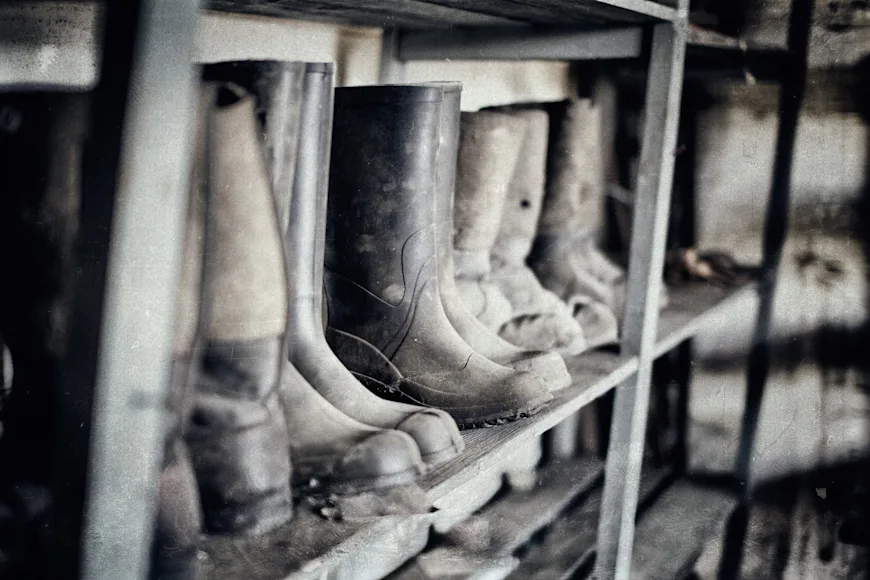_We may earn revenue from the products available on this page and participate in affiliate programs. Learn more ›
_
Rubber boots are trusted waterproof boot options that many wearers rely on to keep their feet dry during work, neighborhood walks, or hunting expeditions. While they are an effective option, what happens when they get a hole or they start to crack? Can they be repaired?
Most of the time, yes, you can repair waterproof rubber boots. How easy they are to repair often depends on the severity of the hole, and much like leather boots
, routine care and maintenance can help them last much longer.
Rubber Boot Care and Maintenance
Compared to other boot styles, rubber boots do not require a high level of maintenance to keep them in good condition. The three main areas of consideration are boot cleaning, conditioning, and storage.
To clean rubber boots, most experts recommend simply using mild soap and water. For the most part, this will do the trick. Like other shoes, keeping the boots free from mud and debris helps prevent the materials from drying out. If you routinely keep your boots clean and they still appear dirty with white or ashy marks, the rubber may go through a blooming process. This process is normal with natural rubber and can be corrected with conditioning. Blooming doesn’t mean the rubber is old or bad, but it can make the boots less pleasant to look at.
In correcting the blooming process and protecting the rubber from early breakdown, conditioning comes into play. Always clean the rubber before conditioning. We recommend conditioning the rubber before the boots start to crack and flake, and this can be done with a rubber conditioner
. Follow the directions on your chosen rubber conditioner for the best results. For most conditioners, apply with a cloth on clean, dry boots every couple of months. Wipe any excess conditioner off the boots and allow them to dry overnight (8-12 hours).
The final care tip for rubber boots is to store them in a temperature-regulated area out of the sun. Avoid storing them outside or in garages that do not have temperature control. These temperature changes can cause the rubber to grow or shrink, cracking and damaging the materials. Whenever possible, ensure the boots are stored upright and do not fold the tops over. Keeping the boots folded can lead to cracking and splitting.
How to Repair Cracks in Rubber Boots
If the boots begin to crack, the rubber is dried out or could be old. However, not all hope is lost! Most cracks in rubber boots can be repaired with a little shoe goo or other adhesives. Small holes can also be repaired in the same manner. Excessive cracking and flaking may mean that the rubber is dry and should be conditioned to attempt to restore the materials.
How to Repair a Crack or Small Hole in Rubber Boots
Clean the boots with soap and water. Take special care to clean the cracked area thoroughly.
Let the boots dry completely.
Smooth out the rough surface of the cracked area with sandpaper. Too much pressure will damage the rubber. The goal is to smooth out any rough surfaces of the boot to help the adhesive bond more easily.
Tape off the area around the cracked area. This will prevent the adhesive from spreading to other areas of the boot beyond the cracked portion. Leave close to ½ an inch of room between the crack and the tape.
Apply your chosen adhesive to the cracked area and cover the ½ inch area up to the tape to prevent the crack from expanding.
Remove the tape and allow the boots to dry overnight (8-12) hours.
Sandpaper the repaired area smoothly once the adhesive is dry.
Read and follow the instructions for your chosen adhesive before repairing the boots. Dry times and other general factors may differ from the instructions provided above.
How to Repair Holes in Rubber Boots
For small holes, follow the same instructions you would when fixing a crack in the rubber. Larger holes need a little more attention, but they can usually be repaired. If the hole is on the bottom of the boot, we recommend resoling the boots. If the hole is on the upper portion of the boots, follow the instructions below.
How to Repair a Large Hole in Rubber Boots
Clean the boots and let them dry.
Get a piece of rubber the same color as the boots and cut the rubber piece slightly larger than the hole. A tube tire repair kit also works to patch holes as long as they are for rubber. You may need to cut these to size as well.
You may need to sand around the patch area or use the small tool provided with a tube tire repair kit to rough up the area around the hole.
Apply adhesive to the area around the hole, even if the patches come with adhesive on the back.
Smooth the patch over the hole. Press firmly, starting in the center and working your way out. Wipe any excess adhesive off or smooth it around the patch’s edges.
Allow the adhesive to fully dry (8-12 hours).
Consider sewing the patch to the boots after applying adhesive for large patch areas or added security. This generally isn’t necessary but can be effective if you are worried about durability.
FAQ
Q: Can you resole rubber boots?
Yes, you can resole rubber boots. Contact a local shoe repair shop if you do not know how to do this or are not confident in your abilities. Resoling the boots often requires a heat gun to remove the soles, cleaning the remaining adhesive, applying the new sole, and cutting it to size.
Q: Does super glue work on rubber?
Yes, superglue does work on rubber. Although it is effective, we still recommend rubber shoe-specific adhesives for the best results. However, if superglue is all you have on hand, it can be an adequate substitute. Superglue is not recommended for rubber that has a high oil or plasticizer content though.
Q: Can rubber be restored?
Depending on the level of damage or degradation, rubber can be restored. For rubber boots, rubber conditioners are the best solution.


